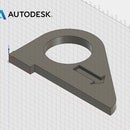Introduction: Introduction to Workholding at the Pier 9 CNC Workshop
This class will introduce you to Workholding at the Pier 9 CNC Workshop for the Haas Mill, DMS 5-axis Router, and Matsuura 5-axis Mill. You will learn how to set up your CAM files in Fusion 360 HSM using custom templates that include precise models of the inside of each machine. Then, you will learn how to set up your vise, load your stock, and set your Work Coordinate System to prepare for machining.
Who should take this class? Pier 9 workshop users who have already been certified on either the DMS, Haas Mill, or Matsuura.
Why should you take this class? This course expands on CAM and machine skills that you have already built by giving you access to a new kind of workholding system, the Lang workholding system, that will increase precision of collision detection in CAM simulation, decrease setup/takedown time for each project because you will not probe your stock, and allow you to pause a project mid-machining or move a project from one machine to another with perfect registration.
How should I take this class? This course is set up differently from other courses because the lessons are not linear. Everyone should take Lesson 1, Introduction to Workholding, as well as Lesson 2, Introduction to Lang Workholding.
From there, branch off and choose the lesson that corresponds to the machine you want to use. Go to Lesson 3 for the DMS, Lesson 4 for the Haas Mill, or Lesson 5 for the Matsuura.
You will need an internet connection, a computer with Fusion 360 installed, and a USB drive. Download Fusion 360 here. If you are a student or educator, download Fusion 360 for free here!
Let's get started.
Step 1: Introduction to Fusion 360 Template Files
We have created dozens of workholding templates for each machine available here. These template files contain a wide variety of workholding configurations for each machine, featuring different vises, stock sizes, jaw orientations, and stock orientations.

When looking for the right template, you will start by choosing a machine. Then you will choose the type of vise you are using, and then a vise and stock configuration (whether the jaws are facing in or out and whether the stock is high or low). Upload the part into fusion and your part into the file, create a joint between your part and the stock, and then check the CAM Setup settings. You will follow along with these steps inside each machine lesson.
Step 2: How the Pier 9 Workholding Folder Works
The Pier 9 Workholding folder hierarchy follows a specific organization:
P9 Workholding/Machine/Vise/Jaw and Stock Orientation
You will follow these steps in detail in each machine lesson, but this is the general workflow:
--Choose a machine
DMS, Haas Mill, or Matsuura
--Choose how many vises you're using (for Haas Mill only)
--Choose a vise
There are four options: The small, medium, or large Lang vise, or the Lang 3-jaw chuck (for circular stock)
--Choose a jaw and stock orientation
For the vises (rectangular stock):
There are two jaw orientations: Jaws In or Jaws Out (dependent on stock size)
There are two stock locations: Part High or Part Low (dependent on surface finish and machining operations)
The naming convention is: Vise size_Jaw Orientation_Stock Location; for example: "Small_In_High"

For the 3-jaw chuck (cylindrical stock):
There are four jaw locations: 1, 2, 3, or 4 (Numbers get larger as stock diameter gets larger)
There are two jaw orientations: Jaws In or Jaws Out
There are two stock locations: Part High or Part Low
The naming convention is: Location #_Jaw Orientation_Stock Location; for example: "2_Out_Low"

In special cases, you will need to build your own template file (although it is usually simpler to edit an existing template). You will do that here:
P9 Workholding/Make Your Own
In general, you will follow these steps:
--Choose a machine base
--Drag the correct component into the machine base, such as a vise or tombstone + vise
--Create a joint between the component and the machine base. Repeat if necessary.
--Save your custom template file inside the P9 Workholding folder.
In the next lesson, you will be introduced to the specifics of the Lang workholding system.














